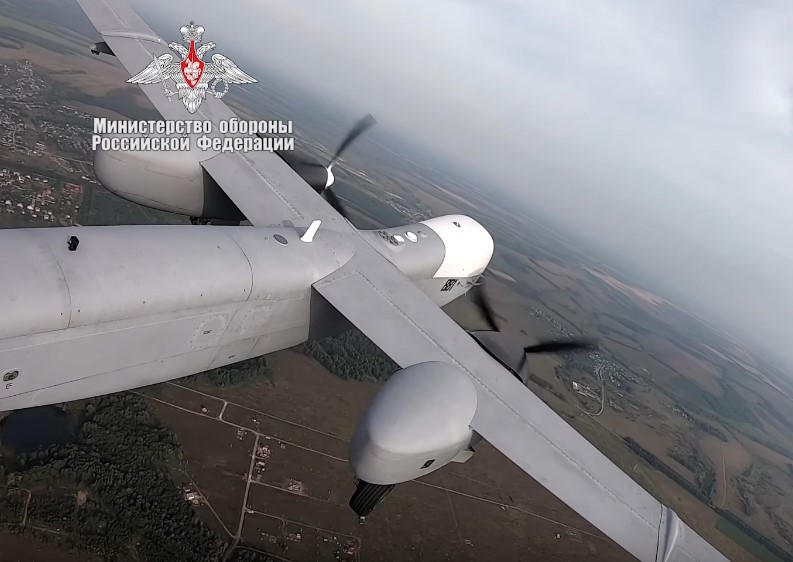A prototype of the Russian reconnaissance and strike unmanned aerial vehicle “Altius” will begin this summer a series of test flights using the entire spectrum of guided weapons, including high-precision missiles, state-run news agency RIA Novosti reported on March 8 citing a source in the military-industrial complex.
“Test flights of the Altius prototype are scheduled for this summer, with the first airstrikes on targets at ranges with air-to-surface guided weapons, including high-precision guided missiles and guided bombs from a complex designed specifically for UAVs,” the agency quoted the source as saying.
The tests will work out programs of typical strike sorties with the destruction of such targets as tanks, lightly armored vehicles, accumulations of mock enemy manpower, and positions of various weapons, including artillery.
Russia’s Altius-M Heavy UAV (01.06.2017):
Written and produced by SF Team: J.Hawk, Daniel Deiss, Edwin Watson
Unmanned aerial vehicles, or UAVs, have become a ubiquitous feature of contemporary warfare. Their use has proliferated to such an extent that even non-state actors boast entire fleets of drones, including ISIS and its seemingly inexhaustible fleet of quadrocopters. Nearly every national military operates a drone force of some sort, starting with lightweight, shoulder-launched battlefield UAVs and ending with the infamous Predators and Reapers or their equivalents. But relatively few countries can boast drones at the high end of that spectrum represented by the HALE, or high-altitude long endurance, family. The onset of flight testing of the Altius-M HALE UAV indicates Russia is about to join that elite group.
As the acronym itself suggests, HALE drones are meant for what essentially are high-importance intelligence gathering missions. The high altitudes at which they operate combined with long loiter times and heavy payloads mean they can provide reconnaissance capabilities second only to those of large electronic surveillance aircraft at fraction of the cost and with far fewer political ramifications. To cite but one example of their utility, NATO’s US-manufactured Global Hawk UAVs have been performing regular flights over Ukraine in order to monitor the battlefield situation in the Donbass. These missions have attracted far less international attentions than had these missions were flown by multirole fighters fitted with reconnaissance pods or heavy electronic surveillance aircraft. Sending NATO aircraft on what would be a de-facto combat mission over a war zone would have been universally perceived as a profound and provocative political statement, while using Global Hawks for the same purpose had no political repercussions. One can even envision HALE drones being sent on intelligence gathering “kamikaze” missions into other countries’ airspace, with the aim of gathering and transmitting as much information as possible before being shot down. While doing that would be extremely provocative and costly with manned aircraft, the use of a drone has a built-in “plausible deniability” because such incursions can be chalked up to equipment malfunctions.
While Russia’s interest in HALE drones predates the wars in Ukraine and Syria, these conflicts made the need for such a vehicle felt more acutely. In order to monitor the events in both conflict zones, Russia had to resort to its small fleet of Tu-214 and Il-20 aircraft. While highly capable aircraft, they were both too much and too little for that task. Too much, because the level of sensor coverage these aircraft provide is geared to high-intensity conflicts with large opposing forces equipped with long-range air defenses. Too little, because the small number of such aircraft made it difficult and costly to establish continuous coverage. Being cheaper to procure and operate, and yet carrying powerful sensors, HALE drones are an important addition to any country’s electronic surveillance and reconnaissance capabilities.
The Altair and Altius-M HALE UAV is intended to become that addition, with the former being intended chiefly for civilian uses such as environmental monitoring and pipeline surveillance. Product of the Simonov Design Bureau in Kazan, the project already exists in the form of two prototypes that are being used for testing purposes. The drone itself exhibits many features of other aircraft in the same category: long, straight wings and extensive use of composites in order to guarantee the necessary altitude and range. It is propelled by two 500hp high fuel efficiency diesel engines. These features give the 7-ton take-off weight vehicle maximum latitude of 12km and range of 10,000km at a cruising speed of 150-250km/hr, which translates into flight endurance of 48 hours. Altius-M’s two-ton payload will enable the drone to carry not only the usual range of optical and thermal sensors, but also a synthetic-aperture ground-surveilance radar with the resolution of .1 meter at the range of 35km and 1 meter at the range of 125km. Its communications equipment allows real-time data transmission at the rate of 30 Mbps to ground stations, UAV retranslators, and satellites. The total budget for the entire program is estimated at about 6 billion rubles, and the vehicles are to become operational in the early 2020s. In addition to the obvious economic and military benefits to HALE drone use, they will also establish Russia as one of the world leaders in heavy UAV development.







Baiktar will look like a stone age thing in comparison to this marvel …